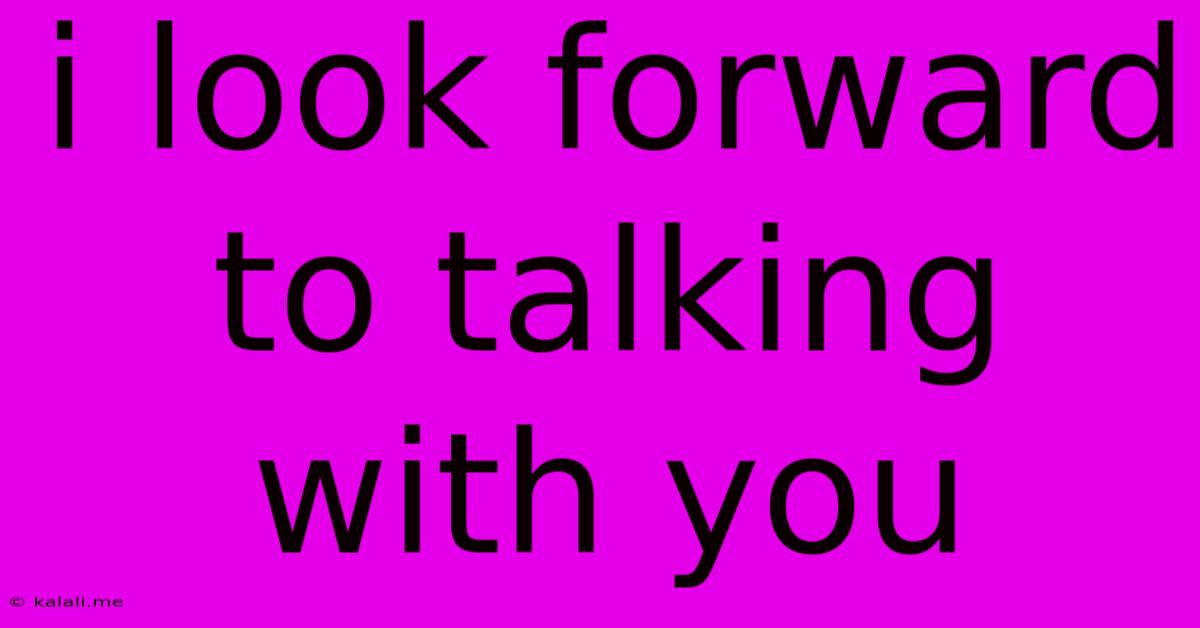I Look Forward To Talking With You
Kalali
May 19, 2025 · 2 min read

Table of Contents
I Look Forward to Talking With You: Mastering the Art of Professional Correspondence
This phrase, "I look forward to talking with you," is a staple in professional communication. It's a seemingly simple closing, yet its effectiveness hinges on context and delivery. This article delves into the nuances of this phrase, exploring its various applications, potential alternatives, and how to use it to create a positive and professional impression. Understanding its subtle power can significantly enhance your communication skills, leaving a lasting impression on recipients.
Why "I Look Forward to Talking With You" Works
This closing line serves several crucial functions:
- Professionalism: It conveys a sense of politeness and formality, appropriate for business emails, letters, and other professional communication.
- Enthusiasm: It subtly expresses your eagerness to engage in further conversation, indicating interest and proactive engagement.
- Positive Outlook: It frames the communication in a positive light, fostering a collaborative and forward-looking tone.
- Call to Action (Implied): While not explicitly demanding a response, it implicitly encourages the recipient to reach out or schedule a conversation.
When to Use "I Look Forward to Talking With You"
This closing is best suited for scenarios where:
- A conversation is anticipated: This phrase works well after scheduling a meeting, phone call, or video conference.
- Further discussion is necessary: If your email or letter requires follow-up, this closing smoothly transitions the communication towards future interaction.
- You want to maintain a professional tone: It's a reliable choice for business correspondence, client interactions, and professional networking.
Alternatives to "I Look Forward to Talking With You"
While effective, there are times when alternative closings might be more appropriate. Consider these options:
- "I look forward to hearing from you": Suitable when you anticipate a written response rather than a direct conversation.
- "I look forward to our conversation": A slightly more formal variation, suitable for important or high-stakes communications.
- "I look forward to discussing this further": Best used when the email focuses on a specific topic needing further elaboration.
- "I look forward to connecting soon": A more modern, informal alternative, suitable for less formal communications.
Improving the Effectiveness of Your Closing:
- Context is Key: Ensure the closing aligns with the overall tone and content of your communication.
- Personalization: Consider adding a personalized touch, such as mentioning a specific topic you'll discuss. For example, "I look forward to discussing the project proposal with you next week."
- Clarity: Avoid ambiguity. Make sure your recipient understands what kind of conversation you're anticipating.
Conclusion:
"I look forward to talking with you" is a powerful and versatile closing that can enhance your professional communication. By understanding its nuances and considering alternative options, you can choose the most appropriate closing to create a positive and professional impression on your audience. Mastering this seemingly simple phrase can contribute significantly to your overall communication effectiveness and build stronger professional relationships. Remember to always consider your audience and the context of your message when choosing your closing line.
Latest Posts
Latest Posts
-
How To Tell If Mozzarella Is Bad
May 20, 2025
-
Fallout New Vegas Power Armour Training
May 20, 2025
-
Best Lubricant For Squeaky Door Hinges
May 20, 2025
-
Telephone Code For Italy From Uk
May 20, 2025
-
The Previous Month As Used In Formal Correspondence
May 20, 2025
Related Post
Thank you for visiting our website which covers about I Look Forward To Talking With You . We hope the information provided has been useful to you. Feel free to contact us if you have any questions or need further assistance. See you next time and don't miss to bookmark.